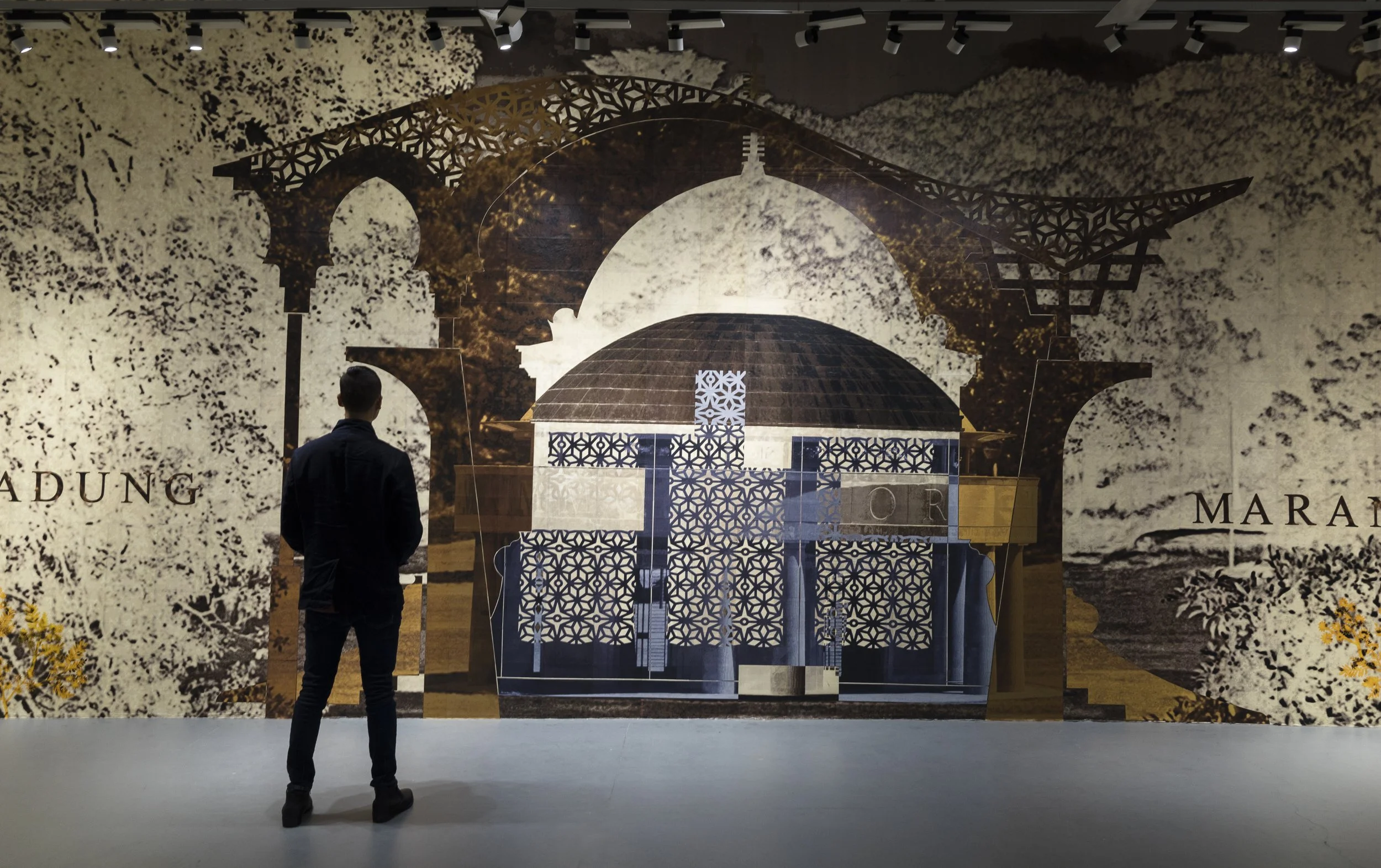
The Pavilion of Clear Memory (when scene from Waverley)
2019, Bondi Pavilion, Sydney.
1,550 individual B&W 80 gsm A4 Laser prints (photocopy) on variously tinted A4 sheets applied to the wall. Created through a dialogistic process with the Year 12 HSC Art Students St. Clare’s College Waverley and the participation of the Costal Bush Regeneration Collective, Bondi and Tamarama.
Conceived of as the elements of a flattened Proscenium Arch Theatre performed around the walls of Bondi Pavilion, this immersive work had 4 distinct zones. Running the entire length of one wall was the Upstage with shorter Left and Right flanking wings, extending at right angles on either side. Opposite the Apron formed by these was the auditorium or “House” in theatre parlance, enacted as another building. An expression of the important role sampling and dubbing, or Spoliation plays in our work. This ancillary pavilion was excavated, displaced and reconstructed from within The Pavilion of Clear Memory which occupied centre stage opposite, refusing to reflect it back unaltered, like a disobedient mirror.
The “character” of The Pavilion of Clear Memory was an imaginary rotunda erected over the top and enclosing Alexander Tzannes’ “Federation Pavilion”, itself erected in 1988 over the top and encompassing the Commonwealth Stone. This massive hexagonal fetish object of polished Moruya granite is a relic of the ephemeral, fibrous plaster 1901 ceremonial pavilion designed by Walter Liberty Vernon. Issues of climatic and demographic change informed the design of The Pavilion of Clear Memory. Its architectural language intended to reflect a future Australia which would be both hotter and more culturally diverse based on current trends. And that any official commemorative edifices would reference these changes, specifically engaging with architectural histories and styles from outside the West, particularly South and East Asia.
Linking the “statues” poised, posed and waiting in the wings are the expressions in Gadi (the Sydney language) - ALLOWAN MADUNG” (I remain brave) and MARANA MULA (First Man/Person). Permission to use these were given in 2001 by Angela Martin and Rosalie Graham as representatives of the original language groups of Sydney. These were cut out, as were the silhouettes of real and imagined statuary, by the Year 12 HSC Art Students at St. Clare’s College Waverley. The students later integrated the elements they had made themselves into the landscape glade in which the Pavilion of Clear Memory is scenically positioned.
Arrayed in the foreground are sprigs of the endangered “Golden Wattle” produced and embedded across the lower section of the image by the Costal Bush Regeneration Collectives at Bondi and Tamarama during a series of workshops, in which they participated as both artists making delicate paper cut outs and activists working to raise wider community awareness of the precarity of costal flora. In particular, the Golden Wattle, which was once abundant in the area and now reduced by over development to six vulnerable specimens protected in gardens at undisclosed addresses.
The “When Scene From Waverley” in the works title refers to the vantage point on the corner of York Road and Oxford Street, at the Northeast of Centennial Park from which the original, working photograph of Tzannes’ elegant, monumental 1988 Federation Pavilion was taken. This point marks the boundary of the Waverley Local Government Area, and the realisation of this project was assisted by a Community Grant from Waverly Council.
Overview The Pavilion of Clear Memory When Scene From Waverley (2019) 4,344 Individual B & W A4 photocopy prints on variously tinted 80 gsm recycled paper (including 1,179 hand cut for image overlay)
“We Won” (2019) Hand cut photocopy overlay of wall mounted statue. Also known as “The Footballer” by Tommaso Sani an early Italo-Australian sculptor active in the 1880’s. The life-sized bronze statue in Centennial Park has the face of a neo-classical Apollo wearing the woollen cap, sweater and tight knee-high britches.
“Land rights Now” (2010-2019) Andrea Fischer of the Birri Gubba language group re-enacting Marcia Langton’s 1969 Land Rights protest (Queens Gardens) First cut out in 2010 with the permission of Marcia Langton.
The Pavilion of Clear Memory (detail) showing Alex Tzannes’s 1988 Federaton Pavilion overlayed on the inverted silhouette of Walter Liberty Vernon’s 1901 Federation Pavilion. Multi-layered photocopy cut-out.
Installation schema (centre stage) Pavilion of Clear Memory. (2019) Alpha-numerical A4 grid
The Pavilion of Clear Memory (detail) MARANA MULA (First Person/Man) cut out overly by and overlay Sunshine Wattle cut outs by the Bondi and Tamarama Costal Bush Regeneration Collective
Year 12 HSC Art Students St. Clare’s College Waverley installing the individual letter R from the word MARNA (First) which they had previously cut out. Printed from the same digital file as the underlying image substrate these overlays are aligned with the underlay before being affixed with wallpaper glue.
Hand cut Sunshine Wattle overlay being aligned and affixed by a member of the Bondi and Tamarama Costal Bush Regeneration Collective
Federation Pavilion Redux (2019) Hand cut photocopy jali screens and hand cut architectural elements including dome, columns and finial.
Federation Pavilion Redux (detail)
Installation schema (centre stage) Pavilion of Clear Memory, wall notes, acknowledgements and credits.
The Pavilion of Clear Memory (detail) incorporating the entablature bearing a carved commemorative text. Federation Pavilion Alex Tzannes, 1988.











